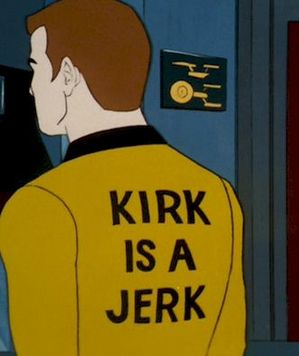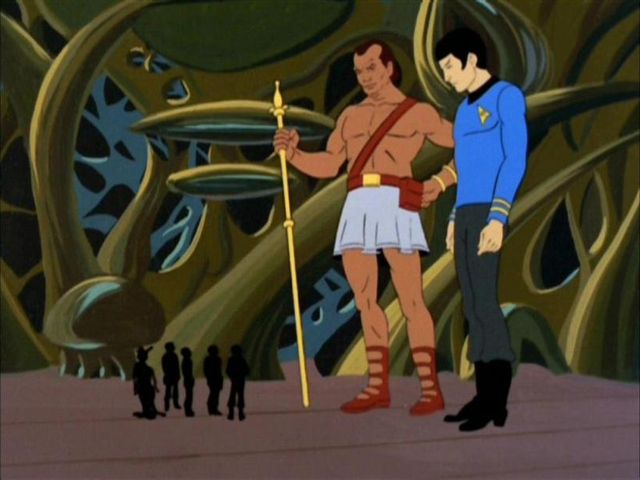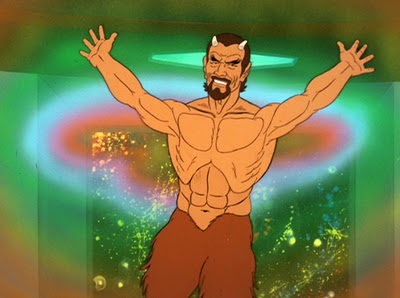The 8 Greatest Episodes of Star Trek: The Animated Series
 |
?Following the cancellation of Star Trek in 1969, the series quickly took on a life of its own thanks to syndication and fans that flat out refused to give up on the show that meant so much to them. Their efforts eventually led Trek to movie theaters, paving the way for all the subsequent TV incarnations of the franchise. But often overlooked in the wake of these huge projects is an unassuming program that first marked the return of Captain James T. Kirk, Mr. Spock, Dr. McCoy and the rest of the Enterprise crew: the animated Star Trek series.
Star Trek remains a joy to watch. Here viewers saw characters like the feline communications officer Lt. M’Ress and alien navigator Lt. Arex that haven’t appeared before or since. The episodes themselves were packed with adventures and creatures that television budgets of the era — or today for that matter — just couldn’t make possible. Sure they were often cheesy or silly, but they were always fun, and some of the best episodes rival that of their live-action counterpart.
To this day, controversy rages over whether or not the events depicted in the animated series should be considered canonical. Officially, it isn’t. Yet elements from the series including Spock’s background and the introduction of the holodeck have snuck their way into mainstream Trek lore. So even if it is the red-headed stepchild of the franchise, there are plenty of pleasures to be found in the cartoon. Here’s a look at the eight greatest episodes of animated Star Trek. Check it out and travel back in time to an era when Saturday mornings were the final frontier.
8) The Lorelei Signal
What Is It About? The Enterprise crew is lured to a planet of space babes. What sounds like Kirk’s dream quickly becomes a nightmare when the women — all of whom appear to be She-Ra’s distant relatives — cause the Captain, Spock and McCoy to age rapidly by draining their life forces. (And not in the fun way). Meanwhile, Uhura reveals her opportunistic side by taking command of the ship when the rest of the male crew becomes too horny to get any work done. Typical.
Why Is It So Great? Liberally borrowing from James Joyce’s Ulysses (as Red Dwarf also did with their similarly themed “Psirens” episode), this installment works as both a fun adventure and an exploration of feminism. The hero of this episode is Uhura, who is forced to act quickly in order to save the crew by beaming down an all-female rescue party to the planet where Kirk, Spock and McCoy are having their energy drained by the strangely Aryan-looking Taurean women. Part of the appeal of the Star Trek animated series is that it often let secondary characters shine, and here we have Uhura’s finest hour. She manages to help put an end to the crisis and save the day without having the resort to fan-dancing. For that, Trekkies remain eternally grateful.
7) The Infinite Vulcan
 |
?What Is It About? Our heroes encounter some plantlike aliens, a refugee from the Eugenics Wars and, best of all, a gigantic clone of Mr. Spock.
Why Is It So Great? I’ve previously mentioned how the Star Trek cartoon gave Scotty, Sulu and Uhura much more to do than in the live-action series and subsequent films. Poor Chekhov however completely got the shaft, never appearing in the cartoon. But pity Walter Koenig not, for he was allowed to write this episode that is a thematic sequel to original Trek’s “Space Seed.” Instead of Khan, here we have Dr. Keniclius, a somewhat morally ambiguous fellow whose demented plan for bringing order to the universe involves killing Mr. Spock so that he can create a massive clone of the Vulcan who can walk around all King Kong-like. Umm, okay. His unclear plan mostly succeeds, and, amazingly enough, giant Spock is left alive and well at the episode’s conclusion…throwing a huge, logic-loving monkey wrench into the hopes of many Trek fans who desperately yearn for the series to be considered canonical. Oh well, at least it gave us the greatest ending of a cartoon ever:
That, my friends, is the very definition of amazing.
6) The Time Trap
What Is It About? While in the midst of exploring the 23rd-century equivalent of the Bermuda Triangle, the Enterprise is attacked by some Klingons led by Kirk’s old nemesis, Kor. During the ensuing fight, both ships are sucked into a surprisingly dull dimension that exists outside of space and time. In order to return to their own universe/avoid a lifetime of boredom caused by the multicultural league of space pacifists who call the area home, they decide to team up in order to escape. As you can imagine, complications ensue.
Why Is It So Great? “The Time Trap” is a mature bit of storytelling that is notable for forcing both the Federation and Klingon crews to (briefly) overcome their differences in order to achieve a common goal. When the Klingon sabotage plot point arises, it just adds tension to an already tight episode. Before you can say “Khitomer Accords,” the uneasy alliance falls apart and the status quo is restored. I’m fine with this. To paraphrase Gul Dukat on a later series, having Kirk and Kor on the same side never really felt right. But it sure made for a solid episode. Meanwhile, I’ve convinced myself that the Bermuda Triangle vibe of this episode stirred up an interest in all-things paranormal within Leonard Nimoy that directly resulted in his In Search Of… gig. I have no way of proving this of course, but stranger serendipities have occurred in the entertainment industry.
5) The Practical Joker
What Is It About? After deciding that dribble glasses are the funniest thing in the universe, the malfunctioning Enterprise computer plays a number of practical jokes on the crew…endangering their lives in the process.
Why Is It So Great? It’s hard not to have mixed feelings about the holodeck. It has been used pretty equally as a device for enabling real drama and a crutch for lazy Trek writers over the years — meaning that for every great episode like Deep Space Nine‘s “It’s Only a Paper Moon” there is a corresponding dismal installment like Enterprise‘s “These Are the Voyages…” (and yes, I know that DS9 had holosuites, but they are basically the same thing). What you may not have realized is that the concept of an area aboard the ship where the officers can go to relax through manufactured reality made its debut in “The Practical Joker.” Although only referred to as the rec room here, it is clearly the template that was used for the holodeck as seen on Star Trek: The Next Generation and all subsequent series’. More than being just another element of the animated series that was cherry-picked into Trek canon and lore, it established one of the most frequently used (and abused) tropes of the franchise: the malfunctioning holodeck. After Scotty, Uhura and Sulu escaped from the rec room in this episode, Starfleet probably should have decided that these virtual reality suites were a bad and very dangerous idea and shut them down for good. But then if this happened, we probably would have never seen Worf in a cowboy hat, met Vic Fontaine…or been enthralled by Captain Janeway’s chats with Leonardo da Vinci. Hmm, on second thought maybe the holodecks really are just awful. One thing everyone can agree on? The computer writing “Kirk is a jerk” on the back on the captain’s shirt is pure genius.
4) The Magicks of Megas-Tu
 |
?What Is It About? During a science observation mission, the Enterprise gets pulled into a spatial anomaly that leads the crew to a planet where they meet a figure who may or may not be the Devil and his equally loopy cohorts. Once there, Kirk and company learn to how to perform some neat magic tricks, almost get beheaded at a recreation of the Salem Witch Trials, then have a few beers with Satan. Hell yeah it’s cool.
Why Is It So Great? I think the above description pretty much sums it up. Watch in in its entirety here and then come back for a discussion. Okay, a few items of note. First off, is it just me or does Lucien look like a dead ringer for Charlton Heston? Was the writer of this episode an anti-NRA crusader or something? Then there’s the issue of Lucien’s true identity. As portrayed here, he is a kindly Devil. I know Vulcans are big on the whole infinite diversity in infinite combinations thing, but should that really apply to the Prince of Darkness as well? While watching this episode, there were a few times — most notably when Spock drew a pentagram and proceeded to perform some dark magic — that I couldn’t believe I was viewing a mainstream cartoon for kids. It is unimaginable that such an episode would get by the censors these days. In short, this is Star Trek gone satanic. It is endlessly awesome. The strangest thing about this entire adventure may as well be how casual everyone acts while being around what could be the greatest form of evil ever envisioned. Instead of being weirded out though, Kirk has a live and let live/let bygones be bygones approach to Lucien and the mystery that surrounds him. Maybe They Might Be Giants are right when they say that you can’t shake the devil’s hand and say you’re only kidding, but as “The Magicks of Megas-tu” makes clear you sure as hell can go drinking with him for a bit.
3) The Survivor
What Is It About? During a patrol near the Romulan Neutral Zone, Captain Kirk and company are shocked to discover a ship belonging to a respected Federation citizen that has been missing for five years. Conveniently enough, the man’s former fianc?e is stationed on the Enterprise. Inconveniently enough for her and the rest of the crew, the man is in fact a shape-shifting alien squid thing intent on jump-starting a war between the Romulans and the Federation.
Why Is It So Great?“The Survivor” attempts to be an adventure, a political thriller and a love story all at once. That it succeeds at juggling all of these balls is a tribute to the writing of James Schmerer. In his only contribution to the series, he crafted an installment that feels the most like classic Trek. Further helping matters along is Ted Knight’s compassionate voiceover performance as Carter Winston, the Federation citizen who has been replaced by the changeling. Knight was a regular on Filmation productions (most notably as the narrator on Super Friends), and his pathos-drenched work here is as far away from Ted Baxter as Insurrection is from The Wrath of Khan. As for the design of the Vendorian alien, the octopus-like creature takes full advantage of the series’ animated medium…and makes one long for a Mego action figure doppelganger of it.
2) Yesteryear
What Is It About? After being involved in a weird timey wimey thing that erased him and his mother from the present, Spock must return to past by venturing through the Guardian of Forever. After traveling through time and space to the Vulcan of his childhood, he comes face-to-face with his 7-year-old self and learns an unexpected lesson in sacrifice.
Why Is It So Great? Just to clarify something about this list, let it be known that “Yesteryear” is hands down the best written episode of the Star Trek animated series. Classic Trek scribe D.C. Fontana crafted a story that packs more Spock character development into 20-odd minutes than the entirety of the three live-action series. Fans of the animated Trek canonicity debate should also note that Vulcan as depicted here would reappear in Star Trek: The Motion Picture and Spock’s tormenting by his peers here was recreated in J.J. Abrams’ Star Trek. Is this a perfect episode? Absolutely. It surpasses any animation limitations to tell an incredibly human story (cue Kirk’s eulogy for Spock from the end of Wrath of Khan). The main reason it doesn’t get the top slot here is because it is such a huge bummer. When Spock’s pet sehlat dies in order to protect his master, viewers are left dealing with an emotional animal death that ranks right along side of Bambi’s Mother and Seymour from Futurama‘s “Jurassic Bark” episode. Dead pets are not a way to end to a Daily List. Space hedonism on the other hand…
1) Mudd’s Passion
What Is It About? Harry Mudd returns to the Enterprise after Kirk takes him into custody for selling fake love crystals to lonely miners. Unbeknownst to everyone, these space roofies actually work. So once they are dispersed throughout the Enterprise’s ventilation system, an epidemic of horniness not seen since “The Naked Time” spreads aboard the ship.
Why Is It So Great? Throughout its brief run the Star Trek cartoon presented sequel episodes to the live-action series several times. None were as delightfully unhinged as “Mudd’s Passion.” From the homoerotic tension of Mr. Spock and Kirk to Scotty’s deadpan response to Lieutenant M’Ress advances (sorry, no getting pussy joke here), this episode is packed with goofy humor that results from the Mudd-induced love virus. Sexual tension? Check. Rock monsters? Uh-huh. The return of a beloved guest star? You betcha. “Mudd’s Passion” has it all. If there’s a complaint to be had here, it’s that the producers didn’t use this episode as an opportunity to wrap things up with a song a la other Filmation cartoons of the era. After all, I bet Spock could play a radiator almost as good as Fat Albert. Nevertheless, the episode is the perfect example of just how fun and funky animated Trek could be.
